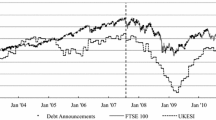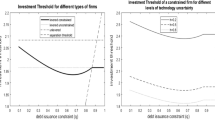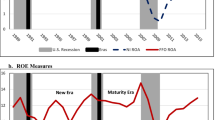Abstract
We show how target debt ratios in book value terms applied to new investment can improve alignment of investment incentives in firms when they have risky debt outstanding and asymmetric information. While wealth transfer from both agency conflicts can reduce the value of existing equity, new debt offsets the value loss to old shareholders. New debt set by the target debt ratio naturally reflects key factors such as the NPV and size of the new project and offsets wealth transfers. Numerical examples show that both agency conflicts can be eliminated both in structural models and in binomial models.
Similar content being viewed by others
Notes
In addition, incentives exist for a firm to take on a negative NPV project in some circumstances because equity holders can still benefit from increasing riskiness thereby transferring wealth from the bondholders to stockholders (risk shifting), as in Jensen and Meckling (1976). However, we focus on firms with positive NPV projects.
Ibid. p.563.
Harris and Raviv (1991) and Stulz (1990) have models which deal with the relationship between management and equityholders–management self dealing—while Diamond (1989) and Hirschleifer and Thakor (1992) deal with the relationship between equityholders and debtholders–asset substitution. The empirical evidence is found in Kim and Stulz (1988), Mikkelson and Partch (1986), Masulis (1980), Millon-Cornet and Travlos (1989), Dann (1981), Vermaelen (1981), Asquith and Mullins (1986), Masulis and Korwar (1986), Schipper and Smith (1986) and Eckbo (1986).
See Harris and Raviv (1991) for a review of this literature.
While a firm makes an investment decision after it observes a realized state at t = 1 in Myers (1977), we assume that a firm makes an investment decision at t = 0 before it knows which state is realized at t = 1. Although highly profitable projects are still retained by a firm with risky debt outstanding with all equity issues in the Myers setup, they could be passed up in our setup because of potential wealth transfer.
A passive investor is one who does not adjust her portfolio in response to a firms issue-invest decisions or when the firm reallocates internal funds between cash and real investments. See Myers and Majluf (1984) p. 188.
Myers and Majluf (1984) p. 207.
\( p=\left( {{e^r}-d} \right)/\left( {u-d} \right)=\left( {{e^{0.05 }}-1/1.5} \right)/\left( {1.5-1/1.5} \right)=0.46. \)
References
Ang JS (1976) The intertemporal behavior of corporate debt policy. J Financ Quant Anal 11:555–566
Asquith P, Mullins DW (1986) Equity issues and offering dilution. J Financ Econ 15(1/2):61–89
Childs PD, Mauer DC, Ott SH (2005) Interactions of corporate financing and investment decisions: the effects of agency conflicts. J Financ Econ 76:667–690
Dann LY (1981) Common stock repurchase: an analysis of returns to bondholders and stockholders. J Financ Econ 9:113–183
De Jong A, Verbeek M, Verwijmeren P (2009) “Firms’ debt-equity decisions when the static tradeoff theory and the pecking order theory disagree”, available at: http://ssrn.com/abstract=1444172. (Accessed 20 November 2010)
De Miguel A, Pindado J (2001) Determinants of capital structure: new evidence from Spanish panel data. J Corp Financ 7:77–99
Diamond DW (1989) Reputation acquisition in debt markets. J Polit Econ 97(3):828–862
Eckbo E (1986) Valuation effects of corporate debt offerings. J Financ Econ 15(1/2):119–151
Flannery MJ, Rangan KP (2006) Partial adjustment toward target capital structures. J Financ Econ 79:469–506
Graham JR, Harvey CR (2001) The theory and practice of corporate finance: evidence from the field. J Financ Econ 60:187–243
Hackberth D, Mauer DC (2009) “Optimal priority structure, capital structure, and investment”, available at http://ssrn.com/abstract=1424107. (Accessed 21 December 2010)
Harris M, Raviv A (1991) The theory of capital structure. J Finance 46(1):297–355
Hirschleifer D, Thakor AV (1992) Managerial conservatism, project choice, and debt. Rev Financ Stud 5(3):437–470
Hovakimian A, Li G (2008) “Do firms have unique target debt ratios to which they adjust?”, Bruch College, available at http://ssrn.com/abstract=1138316. (Accessed 12 December 2010)
Jensen MC, Meckling WH (1976) Theory of the firm: managerial behavior, agency costs and ownership structure. J Financ Econ 3:305–360
Jong A, Verwijmeren P (2007) “To have a target debt ratio or not: what difference does it make?”, RSM Erasmus University, Rotterdam, the Netherlands, Available at http://ssrn.com/abstract=1023581. (Accessed 12 November 2010)
Ju N, Ou-Yang H (2006) “Asset substitution and underinvestment: a dynamic view”, EFA 2006 Zurich Meetings, Available at http://ssrn.com/abstract=686407. (Accessed 12 October 2010)
Kim YC, Stulz RM (1988) The eurobond market and corporate financial policy: a test of the clientele hypothesis. J Financ Econ 22(2):189–205
Masulis RW (1980) Stock repurchase by tender offer: an analysis of the causes of common stock price changes. J Finance 35(2):305–319
Masulis RW, Korwar AN (1986) Seasoned equity offering: an empirical investigation. J Financ Econ 15(1–2):91–118
Mikkelson WH, Partch MM (1986) Valuation effects of security offerings and the issuance process. J Financ Econ 15(1/2):31–60
Millon-Cornet MH, Travlos NG (1989) Information effects associated with debt-for-equity and equity-for-debt exchange offers. J Finance 44(2):451–468
Myers SC (1977) Determinants of corporate borrowing. J Financ Econ 5:147–175
Myers SC (1984) The capital structure puzzle. J Finance 39(3):575–592
Myers SC, Majluf NS (1984) Corporate financing and investment decisions when firms have information that investors do not have. J Financ Econ 13:187–221
Schipper K, Smith A (1986) A comparison of equity carve-outs and seasoned equity offerings: share price effects and corporate restructuring. J Financ Econ 15(1/2):153–186
Scott DF, Johnson DJ (1982) Financing policies and practices in large corporations. Financ Manag 11(2):51–59
Stulz RM (1990) Managerial discretion and optimal financing policies. J Financ Econ 26(1):3–26
Titman S, Wessels R (1988) The determinants of capital structure choice. J Finance 43(1):1–19
Vermaelen T (1981) Common stock repurchases and market signaling: an empirical study. J Financ Econ 9(2):139–183
Author information
Authors and Affiliations
Corresponding author
Additional information
We are grateful to the participants in the Brock Luncheon Series for helpful comments.
Rights and permissions
About this article
Cite this article
Pyo, U., Shin, Y.J. & Thompson, H.E. Reducing agency conflicts with target debt ratios. J Econ Finan 39, 431–453 (2015). https://doi.org/10.1007/s12197-013-9256-0
Published:
Issue Date:
DOI: https://doi.org/10.1007/s12197-013-9256-0




